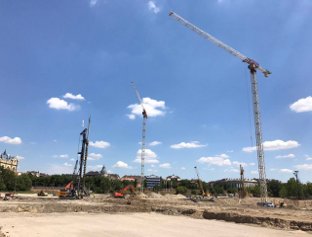Terex team at Ferenc Puskás Stadium
6 December 2018A fleet of Terex tower cranes, from local Hungarian crane rental company TDH Toronydaru Kft., supported by a Demag CC 6800-1 from Sarens, are working on the Ferenc Puskás Stadium in Budapest.
Work on the new stadium has been going on since the beginning of 2017. The soccer stadium is being built at the exact same spot as its predecessor of the same name, which was built in 1953 and torn down in 2016. The construction work is scheduled to be completed in November 2019, at which point the stadium will be able to accommodate 67,000 spectators with its length of over 300m and height of up to 50m.
In order to ensure that the ambitious schedule works, there are 15 tower cranes at the work site. Most of them are Terex models owned by Hungarian crane rental company TDH Toronydaru Kft., and are being assisted by a number of machines, including a Demag CC 6800-1 crawler crane owned by Sarens.
The list of Terex tower cranes being used extends from the GTS 511B, through the CTT 91-2.5 and the CTT 91-5, all the way to the CTT 181 and the CTT 331. TDH Toronydaru technical manager Sandor Zubor says: “On one hand, the Terex tower cranes were perfect for the work site requirements in terms of their heights and lifting capacities; on the other, there are very few cranes of comparable size in Hungary that could have properly tackled the work that needs to be done at the site.”
The fact that the TDH location was close to the work site proved to be a logistical advantage when selecting the cranes. This meant that only half an hour was needed to cover the twelve kilometers of distance between them. “Nevertheless, we still needed a total of about 80 to 100 truck runs to get all cranes to the site,” TDH general manager Dr. Oliver Vonhauser reports. When setting up the cranes for the two largest construction companies involved – Magyar Építo and ZÁÉV –, the Terex cranes’ ease of assembly proved to be a boon for the THD team, which had anywhere from twelve to 14 people depending on the specific unit: Smaller cranes such as the CTT 91 were erected in one single day, and the experienced team only needed three to four days for the larger CTT 331 models.
The logistics involved in transporting the Demag CC 6800-1 crawler crane were significantly more complex, as it had to be taken from its previous work site in Peru to Antwerp by ship, and from there to Budapest by road. The overseas trip itself took a whole 25 days. It would then take another two weeks to set up the crane at the site, with the corresponding work including paving the ground where needed, assembling the Superlift system, and preparing the SPMT modules that would be required as well. The main challenge involved in the setup process was the fact that the Sarens team had to deal with confined spaces available at the work site during crane setup.
However, the Sarens team was easily able to overcome this challenge as well, ensuring that the CC 6800-1 would be able to start tackling its work as planned: Lifting a variety of steel joists for the roof structure. The 125t joists for the outside roof area had to be lifted at a radius of 35m, while the 85t joists for the inside roof area had to be lifted at a radius of 65m.
The Terex tower cranes were set up with hook heights ranging from just under 32m to 85m in order to make sure that they would be able to perfectly take care of their work, completely covering the required lift spectrum. Most of the cranes are set on foundation anchors, although some are mounted on an undercarriage. “The challenge when working with so many cranes at a work site this big is to be able to coordinate them so that the work goes smoothly instead of bottlenecking the actions on the job site,” explains Tibor Major, who helped with the preparations for the project.
In particular, coordinating with the mobile cranes requires an extremely precise and conscientious approach, but it is nothing that the experienced TDH Toronydaru Kft. team cannot handle. “Needless to say, the fact that the operators of the Terex tower cranes and the Demag crawler crane are able to communicate well with each other is extremely advantageous,” points out Peter Nagy, who is part of the TDH Sales Team. In addition, the fact that all the tower cranes used are equipped with inverter drive technology also makes it much easier to coordinate them in terms of working speed and maneuverability.
With these features, the cranes have proven to be able to tackle their demanding work quickly, safely, and reliably, Terex says. And the work is not only demanding, but also extremely varied: It ranges from lifting concrete buckets and rebar to installing prefabricated steel and concrete elements. “So far, everything’s going perfectly smoothly. In fact, we’re pretty sure that our cranes will be able to complete their work at the site by February 2019, i.e., right on schedule,” Oliver Vonhauser says.
On top of this, the Demag CC 6800-1 is playing its part as well, and will have lifted a total of 75 steel structures for the roof.
